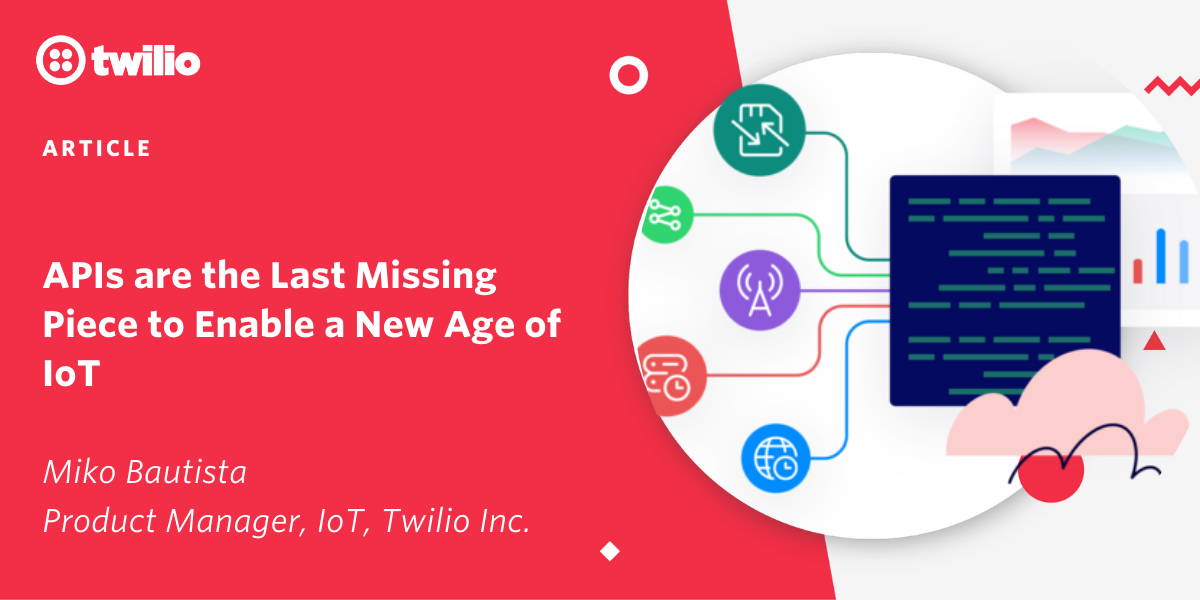APIs are the Last Missing Piece to Enable a New Age of IoT
Time to read: 6 minutes

Now is the perfect time for forward-looking companies to incorporate globally-scaled IoT into their corporate strategy. Smart connected devices act as carriages for these companies to deliver more efficient processes, smarter decision making, and more autonomy to their customers. In this blog post, we will talk about why building IoT solutions is easier than ever before and why achieving scale is only possible by integrating with highly reliable, maintainable, and available APIs.
What sparked the current explosion of IoT use cases
The recent conclusion of the “smartphone war” has left players Apple and Google standing at the top. By now, it’s common knowledge that most smartphone users own either an iPhone or an Android. What might not be as obvious, however, is that the remnants of this war have also gifted technology entrepreneurs with the three building blocks required to develop IoT solutions rapidly and scale them globally.
The first building block was a drastic acceleration in microelectronics R&D. The increased rate at which smartphone vendors (Apple, Samsung) demanded advanced components caused sensor manufacturers to innovate in their space. As a result, we now have accelerometers that can detect movement in 3 dimensions, GPS units that can identify location with pinpoint accuracy, biometrics scanners that can recognize unique fingerprints, and so on.
The second building block was the ubiquity of software applications via mobile devices. 24/7 access to software is no longer a thing of the past. Think about it – when trying to unlock a smart scooter on the side of the road, you’re not going to activate it by logging on to a web browser from your laptop. You would do so via a mobile app on your phone or watch. Modern software frameworks have massively reduced the effort to create both the app itself and the back-end cloud infrastructure.
The last building block was the proliferation of connectivity technologies. Innovations in this space have unlocked a plethora of means by which devices can communicate with one another. Developers now have the luxury of selecting the most ideal method that caters to their customer’s needs. To name a couple, low-data short-range Bluetooth Low-Energy or “BLE'' is the perfect choice for devices that need to send small amounts of data across short distances, such as a smart thermometer that measures the ambient temperature once per minute. Meanwhile, Long Term Evolution or “LTE”, three letters that most smartphone users have stumbled upon by now, is hugely popular for use cases that require much faster cellular data transmission speeds, such as high-quality video streaming.
The challenges that come with scaling IoT solutions
The IoT explosion continues in 2022, with the market forecasted to exceed USD$1.5 trillion by 2025 at over 10% YoY growth rates. As companies deploy more connected devices to solve a myriad of mission-critical customer needs, managing these devices at scale becomes increasingly challenging. For example, as a micro-mobility business, how do you ensure that your smart scooters will connect to the most reliable cellular network as your riders travel from one location to the next? As a home automation company, how do you ensure that none of your smart locks are low on battery and won’t compromise your homeowner’s safety? As a medical device manufacturer, how do you ensure that all of your devices are running the most up-to-date firmware, guaranteeing that your patients’ vitals are stored and handled in a secure manner? Providing a reliable and consistent experience becomes increasingly difficult when IoT devices must be deployed across different countries, environments, and scenarios.
The challenges described above can be categorized as follows: connectivity management, data processing, and device security. Next, we will discuss these hurdles and learn how APIs can be leveraged to solve all three.
Connectivity Management
Picture that you are the CEO of a smart scooter business. To deliver the best customer experience, your scooters must connect to the cellular network that provides the most reliable signal wherever they travel to. From an execution standpoint, what does this mean for your company? First, your business development team will have to form partnerships with each of the major cellular providers in the countries which your business operates. Then, as the scooters move around from one location to the next, your engineers will have to program them to switch between networks whenever they detect a stronger signal. Finally, as the scooters consume cellular data, your financial analysts will have to sort through all the separate bills that come from each connectivity provider. Sounds like a ton of additional work, doesn’t it? The worst part is that this problem only compounds if you want to expand your business into another country tomorrow. The idea of achieving global scale quickly becomes a stretch.
Today, companies called cloud-native providers' are building solutions that take care of these logistical headaches for you. For example, Twilio IoT’s Super SIM handles partnering with cellular network providers across the globe, programming intelligent network-switching logic, and architecting easy-to-understand cost infrastructure. All these features are bundled into one package, so that your company only has to deal with one bill from one company. On your end, all you’d have to do is to integrate with Super SIM APIs – a task accomplished with just a few lines of code. With this approach, scaling to another 5, 10, or 50 countries requires minimal effort from a connectivity management standpoint.
Data Processing
Next, let’s place ourselves in the shoes of a home automation manufacturer. Among the millions of devices that you have deployed around the world, how can you easily detect the one smart lock that needs its battery replaced and inform its owner in a timely manner? Without integrating with external APIs, the only way to do so would be to set up your own in-house infrastructure. Doing so from the ground-up would require installing server clusters around the world. All of your smart devices would be communicating with these servers, and so they would need to handle processing massive quantities of data. You would have to guarantee that these servers run into minimal downtime throughout the year and will likely have to hire a dedicated DevOps team just to manage this.
Fortunately, there are APIs out there that provide data management and processing for you. You might have heard of cloud services such as Amazon Web Services and Microsoft Azure, but there are also corresponding offerings that focus on IoT use cases, respectively called AWS IoT and Azure IoT. How they differ from the originals is that they support device protocols which are most ideal for the IoT use case, including MQTT (Message Queueing and Telemetry Transport) and LoRaWAN (Long Range Wide Area Network).
Device Security
For our last example, let’s imagine that we are producers of medical device hardware. Let’s say that one of our clients, a hospital, just informed us that one of their smart heart rate monitors is no longer functioning as expected. There seems to be an issue with the code running on the device itself and there is no way for us to continue diagnosing their issue without sending in a customer representative. We are especially worried because we suspect that the device is running outdated firmware with identified security vulnerabilities. To mitigate these problems in the future, perhaps we could hire dedicated specialists who could physically visit our clients’ sites whenever they receive a support request. However, that solution does not sound even remotely scalable.
At present, Twilio IoT is working on a product called Microvisor to address this exact pain point. With Microvisor, your developers will be able to debug code running on the device itself without having to be physically located next to it. Your developers will also be able to ensure that your customers are always running the latest firmware versions by issuing over-the-air (OTA) firmware updates. Both these tasks of remote debugging and issuing OTA updates can be done from anywhere around the world, so it does not matter where your developer is located.
Conclusion
Today, forward-looking companies are presented with the perfect opportunity to incorporate IoT into their product strategy. Such investments can either enhance existing solutions to known problems or unlock new solutions to problems that couldn’t have been addressed before. The remnants from the smartphone war have just made this possible in recent years.
However, there are countless nuances to successfully scaling an IoT product, any of which can easily detract a company from focusing on its core competency. By leveraging an ecosystem of APIs that others have built, companies are able to stay focused on solving the customer needs they are most familiar with while simultaneously growing in a scalable and sustainable manner.
Related Posts
Related Resources
Twilio Docs
From APIs to SDKs to sample apps
API reference documentation, SDKs, helper libraries, quickstarts, and tutorials for your language and platform.
Resource Center
The latest ebooks, industry reports, and webinars
Learn from customer engagement experts to improve your own communication.
Ahoy
Twilio's developer community hub
Best practices, code samples, and inspiration to build communications and digital engagement experiences.


